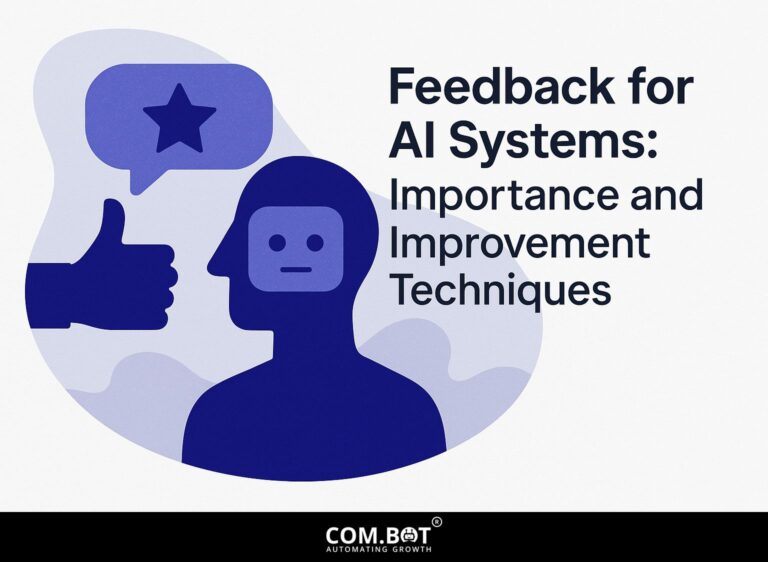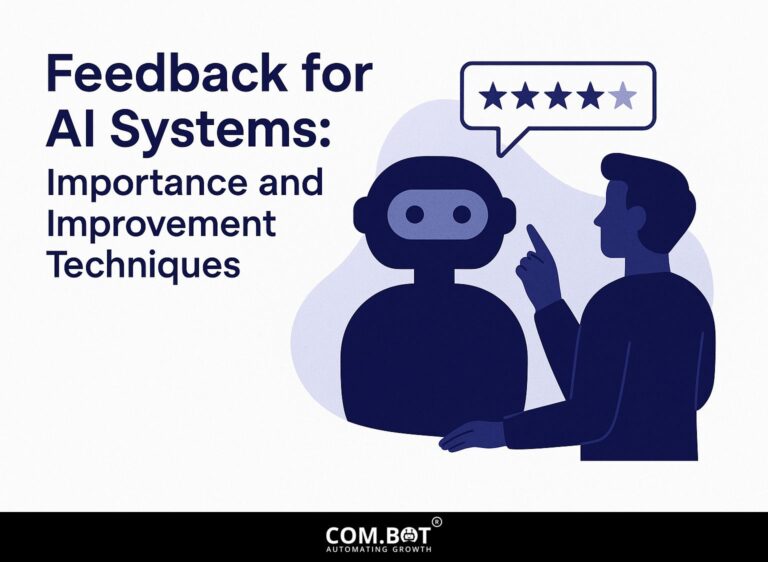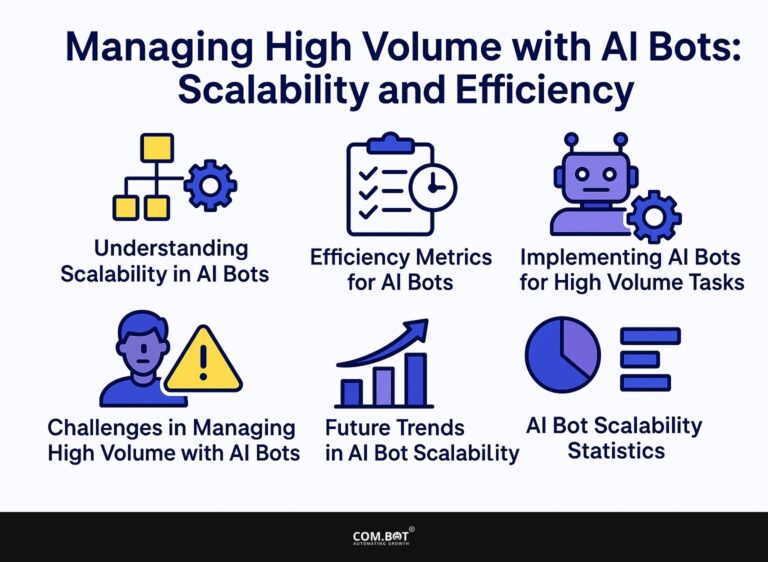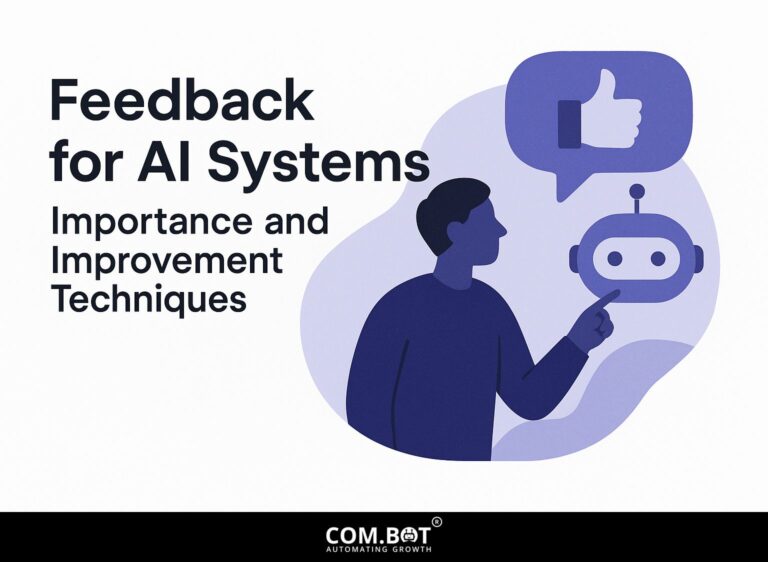Feedback for AI Systems: Importance and Improvement Techniques
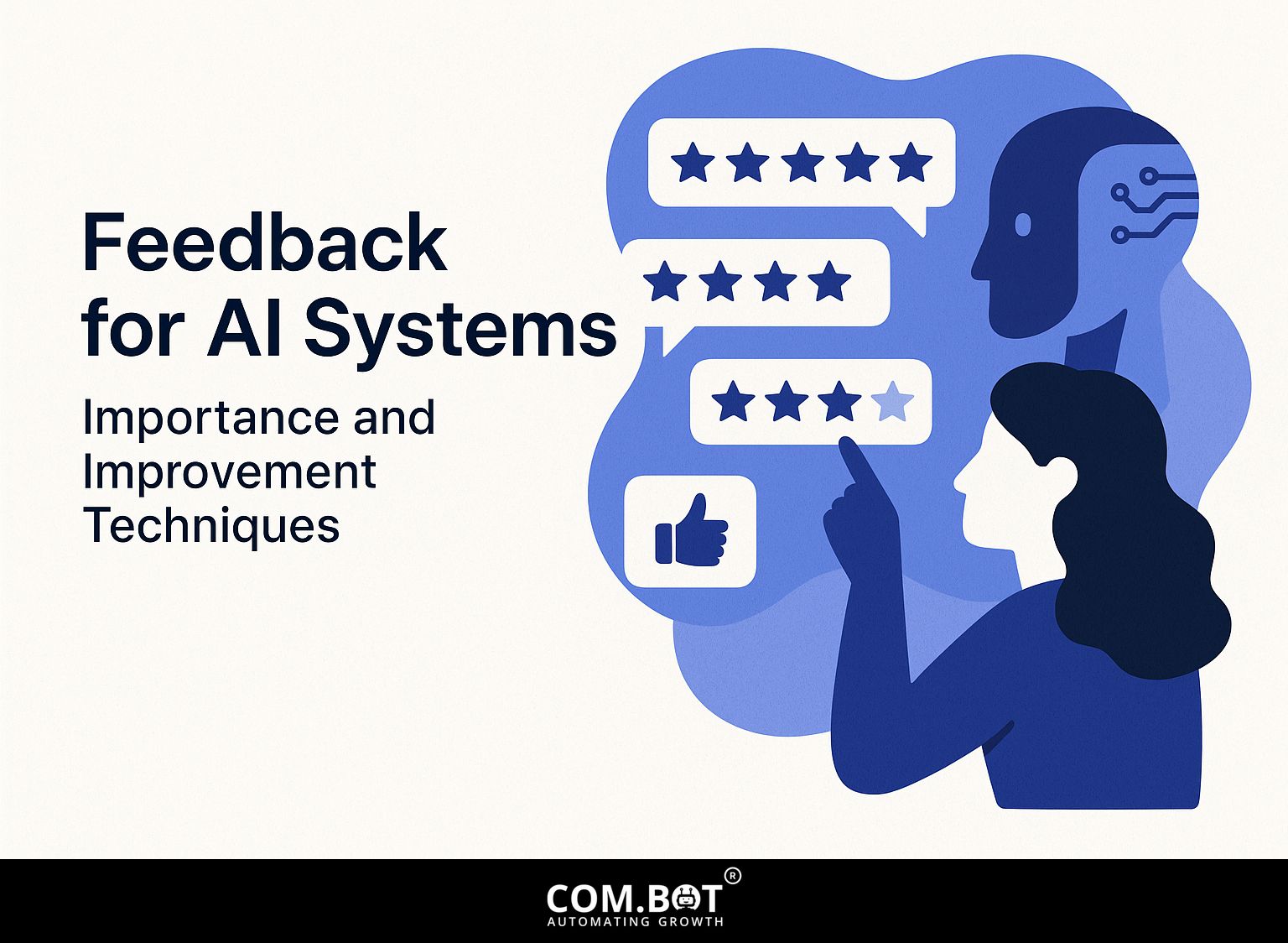
As artificial intelligence becomes more common, knowing how human feedback affects machine learning models is important for improving them. Feedback mechanisms, like those employed in Label Studio, directly influence large language models and reinforcement learning systems. This article looks at why human input is important in AI development and offers practical tips for making feedback better, so AI systems become more accurate and easier to use. Learn how giving feedback can influence the development of AI.
Key Takeaways:
- 1 Importance of Feedback for AI Systems
- 2 AI Feedback Mechanism Impact
- 3 Types of Feedback Mechanisms
- 4 Techniques for Gathering Feedback
- 5 Implementing Feedback for Improvement
- 6 Challenges in AI Feedback Implementation
- 7 Future Directions in AI Feedback
- 8 Frequently Asked Questions
- 8.1 What is feedback for AI systems and why is it important?
- 8.2 How does feedback improve AI systems?
- 8.3 What are some common techniques for providing feedback to AI systems?
- 8.4 Can feedback be biased and affect the performance of AI systems?
- 8.5 What are some ways to improve the quality of feedback for AI systems?
- 8.6 How can AI systems use feedback to handle new situations?
Definition of Feedback in AI Systems
Feedback in AI systems is the data given to make algorithms better, which can come from users, performance measurements, or computer systems.
This feedback is important for making gradual improvements, helping systems learn from errors and improve over time.
For example, user feedback can lead to adjustments in user interfaces, while performance metrics can highlight areas requiring optimization, such as processing speed or accuracy.
Automated systems can use A/B testing results to make algorithms better. Tools like Google Analytics or user surveys are effective for gathering data, ensuring that AI models evolve to better meet user needs and apply learnings from real-world applications.
Overview of AI System Applications
AI systems are used in different areas, such as healthcare for analyzing medical images and finance for forecasting trends, often improving through regular feedback.
In healthcare, AI improves the accuracy of diagnoses by examining medical images and learning from doctors’ feedback. For example, systems like IBM Watson use information from past diagnoses to make better predictions later.
In finance, AI algorithms improve trading strategies by studying market trends and changing based on live performance data. Tools like Bloomberg Terminal use user feedback to keep updating predictive models.
By continually evaluating and improving, these systems grow, leading to improved performance and efficiency in their areas. Related insight: Feedback for AI Systems: Importance and Improvement Techniques.
Importance of Feedback for AI Systems
Feedback systems help improve AI accuracy and efficiency, leading to greater user satisfaction and trust in these systems. Understanding the importance and improvement techniques of feedback mechanisms can further enhance these benefits.
AI Feedback Mechanism Impact
AI Feedback Mechanism Impact
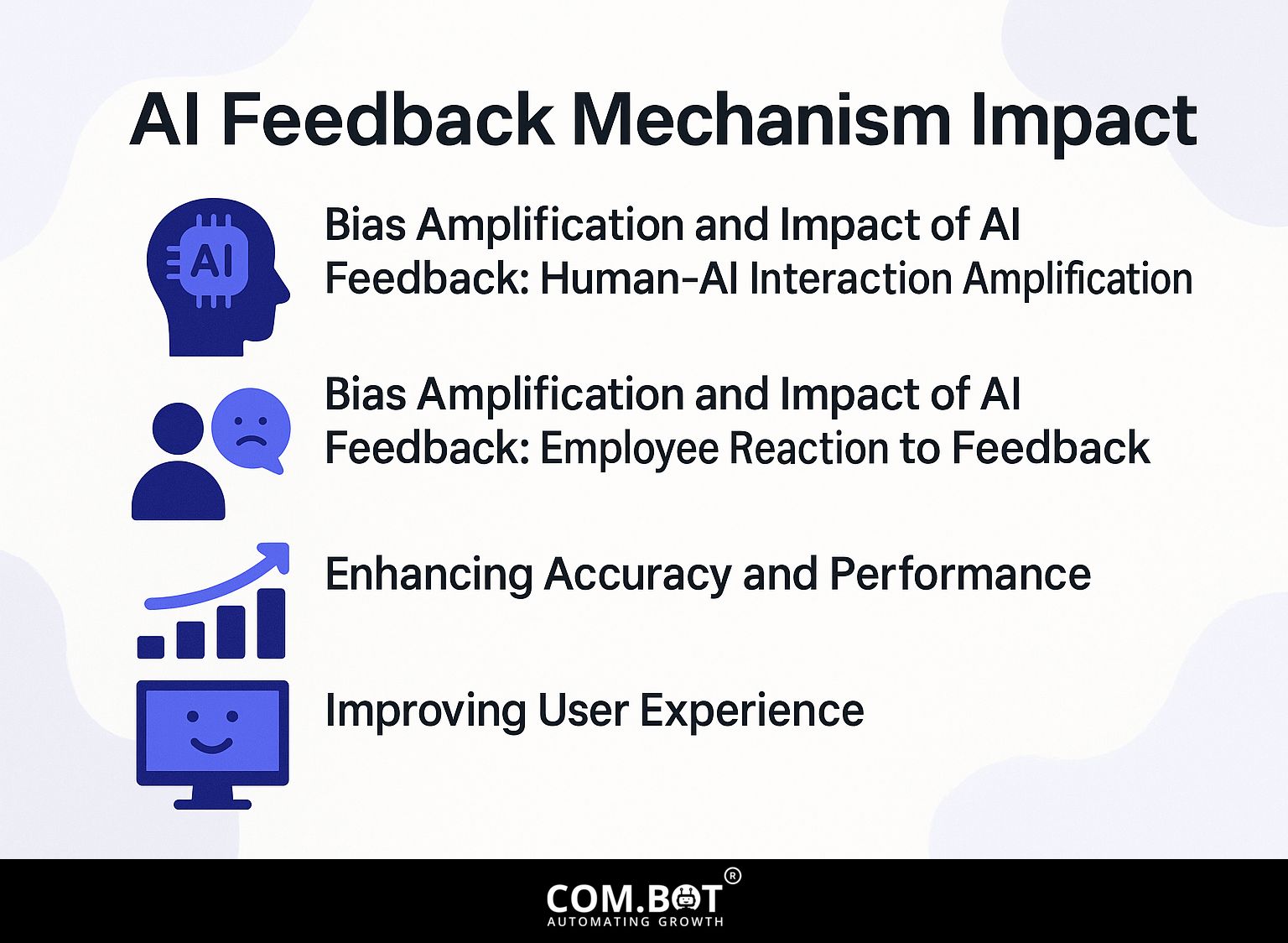
Bias Amplification and Impact of AI Feedback: Human-AI Interaction Amplification
Bias Amplification and Impact of AI Feedback: Employee Reaction to Feedback
The AI Feedback Mechanism Impact The information looks at how AI affects interactions in workplaces. It focuses on how AI can increase bias and what that means for how people make decisions and how employees respond.
Bias Amplification and Impact of AI Feedback addresses the extent to which AI systems can magnify existing biases in human-AI interactions. The data shows that AI amplifies bias by 15% compared to its original source, indicating that AI can inadvertently strengthen pre-existing biases in data or human decisions. Over interaction blocks, there’s an AI-induced bias increase of 6%, suggesting that repeated AI interactions can gradually escalate bias. The 38% impact on human judgment AI plays a big role in decision-making, possibly changing how people think and the results based on its advice.
The section on Employee Reaction to Feedback looks at how feedback from AI can change how employees act and view themselves. A small percentage ( 0.16% ) of employees exhibit withdrawal behavior due to AI feedback, indicating a minor but notable group who may disengage from tasks or teams in response to AI assessments. Similarly, 0.18% experience a reduction in self-efficacy “”, which means they feel less sure about their skills because of comments from AI. This could impact overall performance and morale if not addressed. In contrast, 80% feel shame induced by leader feedback The difference between feedback given by AI and human leaders is clear. Feedback from human leaders has a much stronger emotional effect than feedback from AI.
The AI Feedback Mechanism Impact Data highlights the two-sided nature of AI feedback mechanisms. While they provide clear information, they can also continue biases and heavily affect how people make decisions. For employees, while the emotional impact of AI feedback is less than human feedback, it still affects self-efficacy and engagement. Organizations need to design AI systems carefully, with checks to minimize bias amplification and support systems to address any negative consequences of AI feedback on employees.
Enhancing Accuracy and Performance
Implementing feedback can reduce model error rates by up to 30%, directly improving the accuracy of AI-driven predictions and actions.
To achieve this, organizations can use repeated training methods. For example, a study using Google’s TensorFlow showed how using user feedback during the training process helped models adjust more quickly to changing data patterns.
Tools like FeedbackFruits help with peer reviews that collect different views, improving model accuracy even more. By consistently using feedback from end-users, companies improve AI results to better match user needs, making them more effective and reliable in different applications. This approach aligns with the principles outlined in our analysis of feedback for AI systems and improvement techniques.
Improving User Experience
By using real-time feedback, AI applications can change based on how users interact with them, which has led to a 25% rise in user satisfaction scores.
To make use of this potential, tools like UserVoice or Hotjar can be used to collect user opinions regularly.
For example, UserVoice allows users to suggest new features and vote on others, creating a prioritized feedback list.
Hotjar, on the other hand, provides heatmaps and session recordings, helping developers understand how users interact with their applications.
Frequently reviewing this feedback improves things and involves users in the process, building a sense of belonging and accountability that enhances their experience.
Types of Feedback Mechanisms
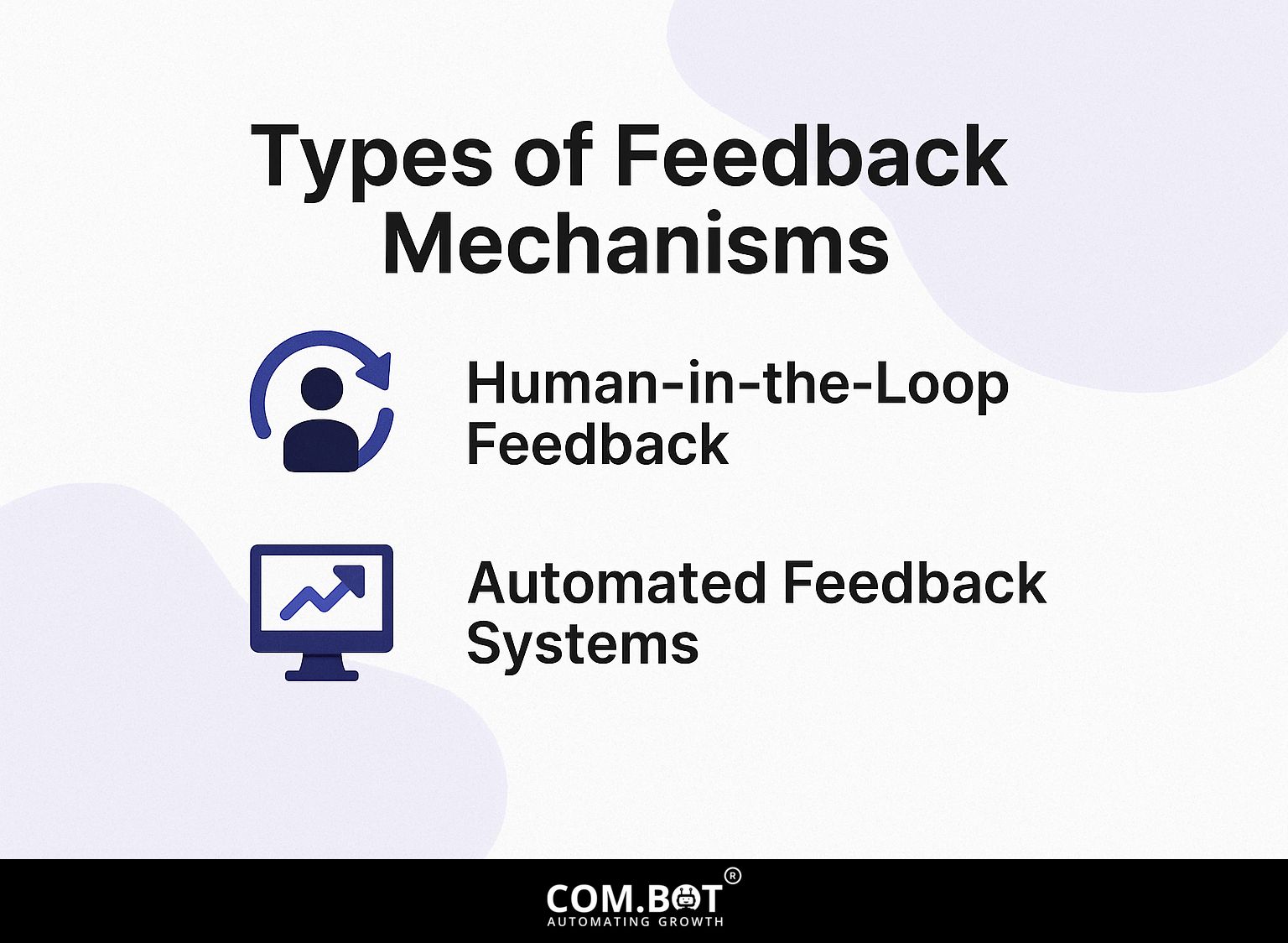
AI systems can use different feedback methods, each with its own benefits and difficulties in improving how the system learns. Understanding these methods is crucial for optimizing AI performance. Learn more about the importance of feedback and improvement techniques that can enhance AI learning processes.
Human-in-the-Loop Feedback
When people take part in giving feedback, they can include their judgment in AI training, providing thorough information that fully automated systems might miss.
This approach is critical for enhancing model accuracy and reliability.
For example, tools like Label Studio allow users to annotate data effectively, providing targeted feedback on AI predictions. Likewise, Amazon SageMaker has features for human review, allowing data scientists to improve their models using real-world feedback.
By gathering feedback from people at various stages, organizations can significantly improve their AI systems, ensuring they are precise and align with user needs and preferences.
Automated Feedback Systems
Automated feedback systems use performance measurements to update AI models instantly, often relying on algorithms to analyze data trends and outcomes.
For instance, reinforcement learning algorithms like Q-learning and Proximal Policy Optimization can modify AI behaviors based on real-time feedback. Tools like TensorFlow and PyTorch offer the necessary structures to carry out these algorithms effectively.
By integrating continuous learning approaches, such as A/B testing for model performance, systems can evolve with minimal human input. In practice, companies like Netflix use systems that automatically improve their recommendation algorithms, showing how these methods increase user interaction with technology that can manage large-scale operations.
Techniques for Gathering Feedback
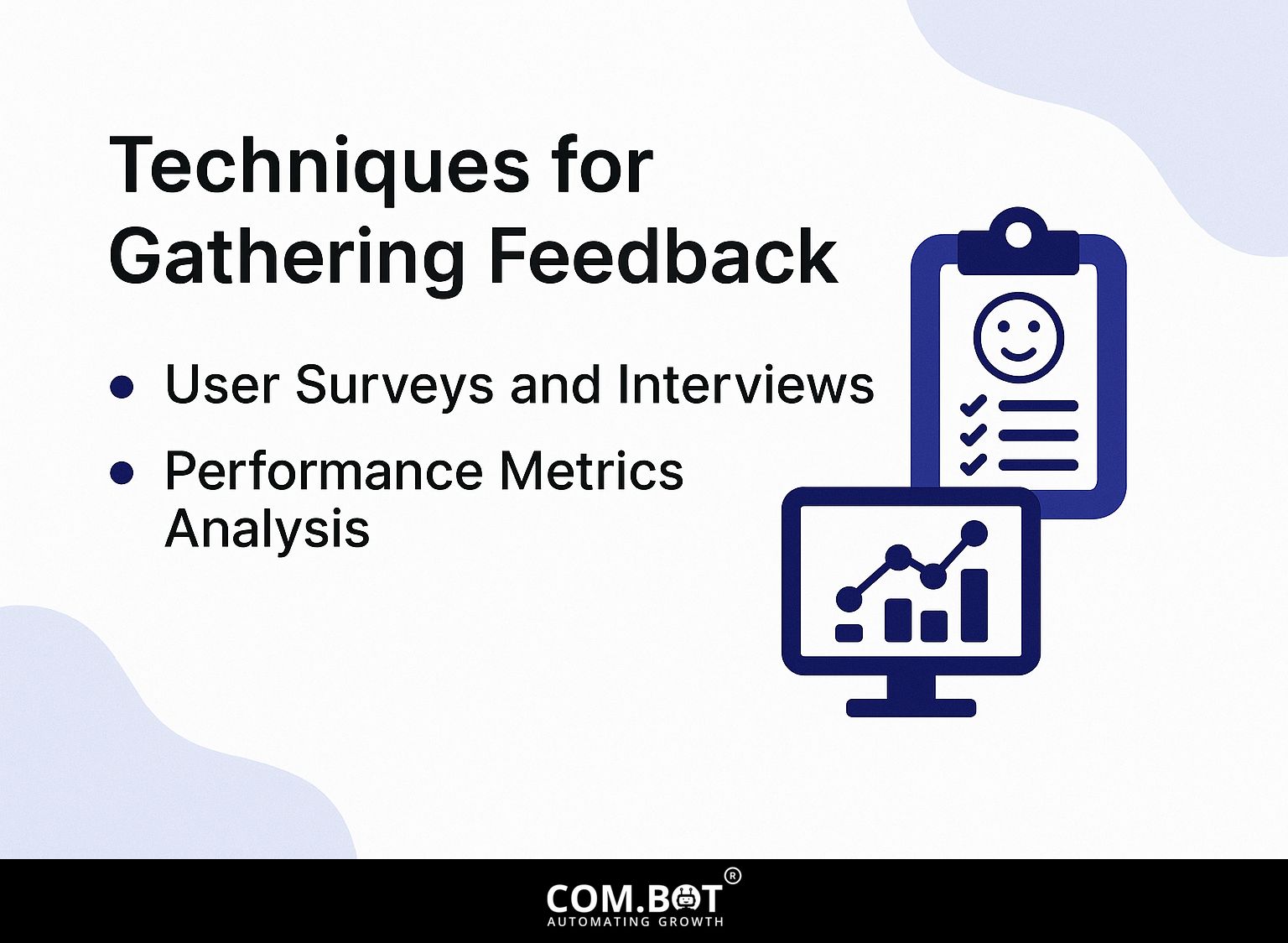
Collecting useful feedback involves using user surveys, interviews, and examining performance data to improve AI.
User Surveys and Interviews
Doing user surveys can give important information. A recent survey showed that 70% of users like to give feedback using brief online forms.
To create useful user surveys, you can use SurveyMonkey for its easy-to-use setup and detailed reports, or Google Forms for a free and simple option.
Focus on creating clear and short questions. Mix multiple-choice with open-ended formats to collect various responses.
To get more replies, send email invites with custom messages and specific end dates to encourage quick responses. Sharing the survey on social media can increase its reach, leading to more people expressing their opinions.
Performance Metrics Analysis
Reviewing performance measurements is key to seeing how well AI works. Measurements such as accuracy, exactness, and recall provide straightforward feedback.
To analyze these performance numbers well, use tools like Google Analytics for website models or Tableau for visualizing data.
Begin by establishing clear KPIs that align with your AI objectives. For example, if you’re looking at a recommendation system, concentrate on accuracy (how many suggested items are useful) and coverage (how many useful items are included).
By frequently reviewing these metrics, you can spot where changes are needed, making sure your AI models work well over the long term.
Implementing Feedback for Improvement
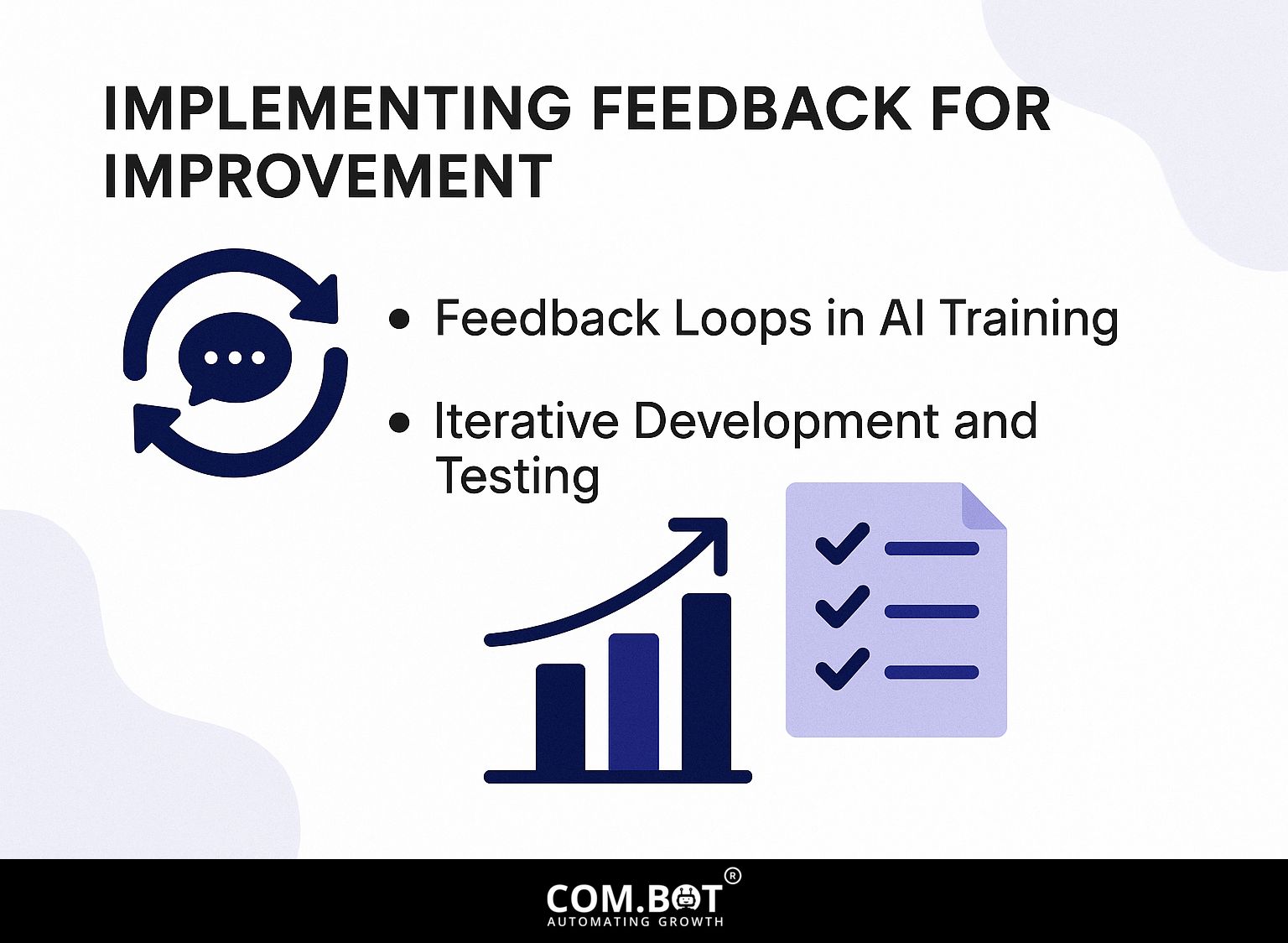
Using feedback successfully needs a clear method to include suggestions into AI model training and continuous improvement steps.
Feedback Loops in AI Training
Feedback loops are essential for AI learning, letting systems improve their algorithms regularly by using information from user interactions and performance results.
Platforms like Netflix look at what users watch to improve recommendations. When a user watches a specific genre, the system updates recommendations in real-time, thereby improving user satisfaction.
Google’s search engine improves results by considering how often users click on links and their opinions. Tools like TensorFlow and PyTorch help developers change model settings on the fly.
By using user data in the training process, AI can improve its accuracy and relevance over time, leading to better user engagement.
Iterative Development and Testing
Improving AI models involves regularly getting input and testing them, which helps them work better with unfamiliar situations.
Key tools facilitate this process. Git offers strong version control, letting teams monitor changes and work together smoothly on code.
Jupyter Notebooks offer an interactive environment for data analysis and model testing, where users can visualize results in real-time.
These tools let developers try out different model versions and keep a full history of changes, making it easy to revert to earlier versions if necessary.
This process creates a more organized way to develop, leading to better AI products.
Challenges in AI Feedback Implementation
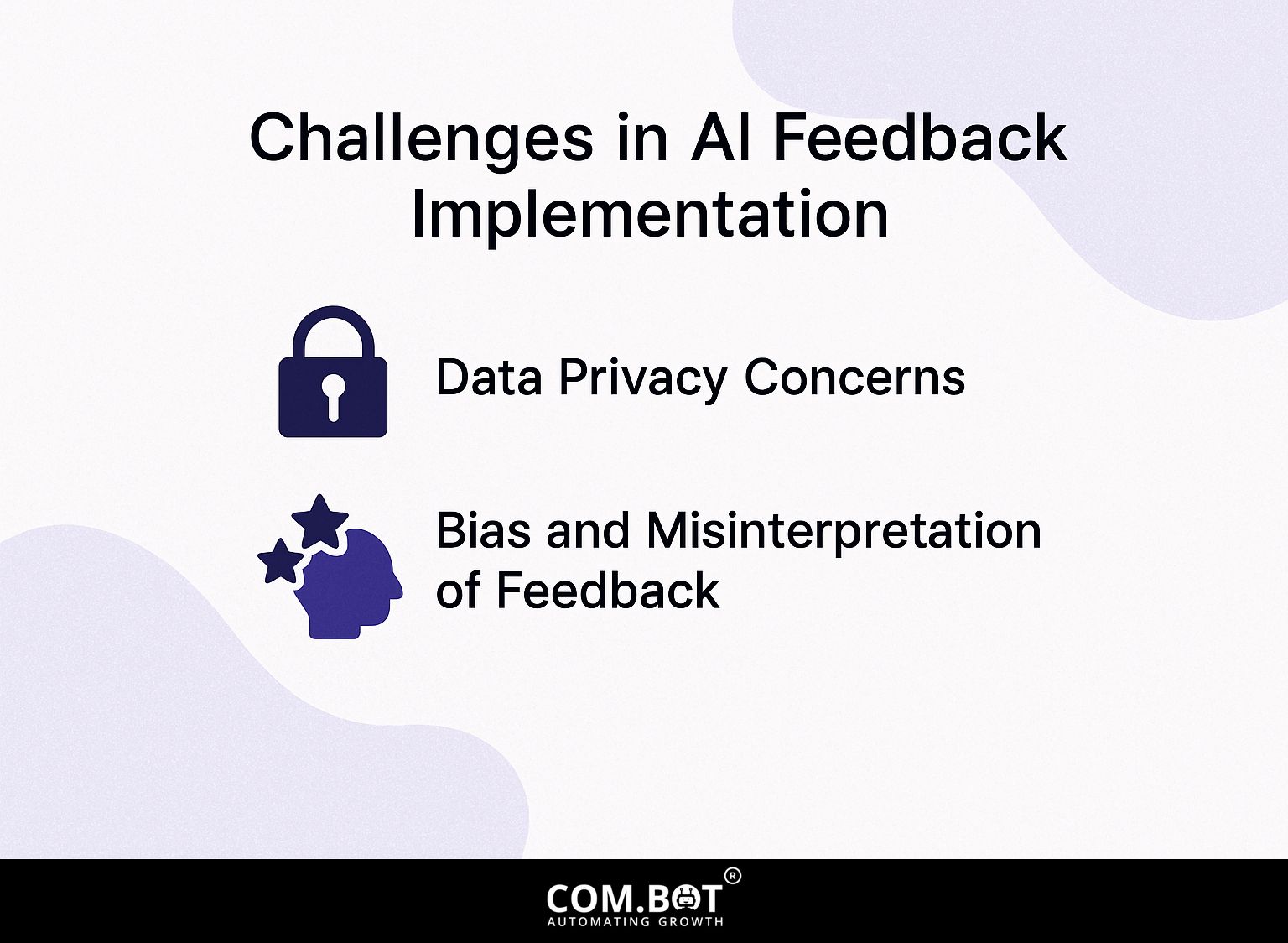
Even though it has advantages, adding feedback in AI systems has issues like data privacy worries and the risk of bias. For an extensive analysis of these challenges, our comprehensive study on feedback for AI systems examines the importance and offers improvement techniques.
Data Privacy Concerns
Data privacy remains a significant concern, with 52% of users hesitant to provide feedback due to fears over data misuse and security breaches.
To address these concerns, organizations should be open about how they use data, follow regulations like GDPR, and put strong security measures in place.
For example, businesses can use encryption tools such as VeraCrypt to protect sensitive information. Allowing users to simply choose whether to share feedback and giving them easy ways to manage their data settings creates confidence.
Regularly updating privacy policies and training employees on data handling practices shows a commitment to user privacy, encouraging customers to engage.
Bias and Misinterpretation of Feedback
Bias in AI can arise from misinterpreted feedback, leading to skewed outcomes and reinforcing existing cognitive biases within the data.
To reduce bias, it’s important to use varied training data. Begin by gathering information from different groups and perspectives to include everyone.
With tools like Google’s Data Studio, you can show different data sets, which makes it simpler to spot potential biases. Employing techniques such as cross-validation with varied datasets can help identify and rectify biases during model training.
By carefully selecting the input data and frequently checking the model results, organizations can improve the fairness and accuracy of their AI systems.
Future Directions in AI Feedback
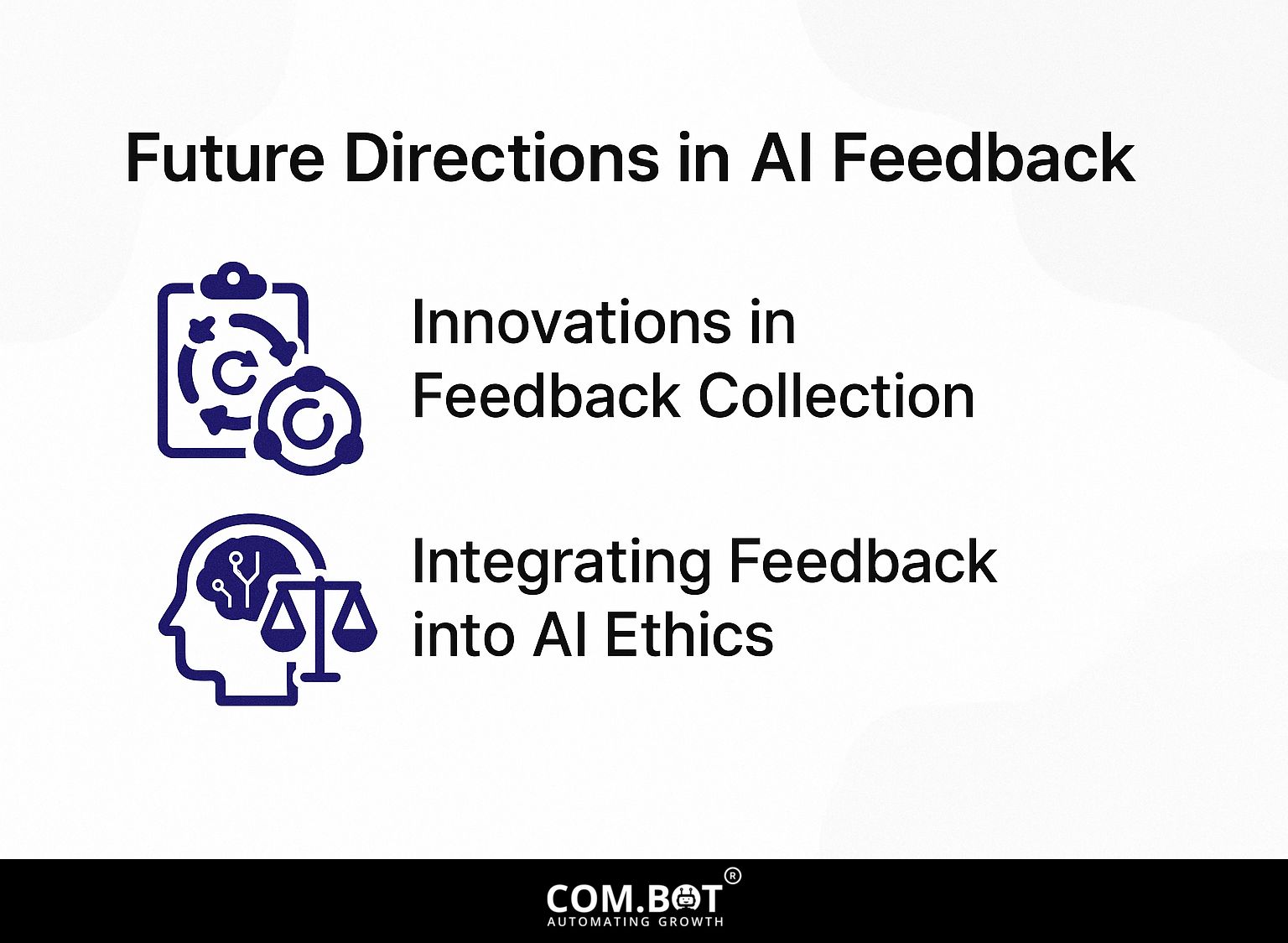
The development of AI feedback is set to improve, with better ways of gathering data and a greater focus on ethical issues changing the field.
Innovations in Feedback Collection
New methods like sentiment analysis and tools that collect feedback instantly are changing how AI systems adjust to what users say.
Tools like Amazon Comprehend and Google Cloud Natural Language can analyze user sentiment and feedback in real-time, allowing systems to adjust their responses accordingly.
For instance, integrating sentiment APIs into chatbots enables them to gauge user emotions and provide more empathetic replies.
Using platforms like UserVoice can help collect user feedback easily, forming a process where AI learns from direct user interactions.
Responsive features make systems more user-friendly and simpler to grasp.
Integrating Feedback into AI Ethics
Including feedback in AI ethics requires setting rules that make sure feedback processes are fair, open, and promote variety in AI use.
To put good feedback methods in place, organizations can use plans such as the AI Ethics Guidelines from the European Commission. The guidelines suggest that AI systems should openly share how they make decisions with users.
Having different people on advisory boards can improve feedback by bringing in many viewpoints. Tools like the Ethical OS Toolkit help spot possible problems in using AI, while regular user surveys can measure public opinion and encourage responsibility.
By directly dealing with these factors, companies can create trust and improve the ethical standards of their AI systems.
Frequently Asked Questions
What is feedback for AI systems and why is it important?
Feedback for AI systems means giving information to the system about how well it is performing and the outcomes it is achieving, to make it more accurate and effective. This is important because AI systems depend on data and ongoing learning to make choices. Without feedback, they cannot get better or adjust to new situations.
How does feedback improve AI systems?
Through feedback, AI systems get information about how well they are doing, which they can use to change their algorithms and make better predictions or decisions. This allows the system to continuously learn and improve its performance over time, leading to more reliable and efficient results.
What are some common techniques for providing feedback to AI systems?
Some common techniques for providing feedback to AI systems include manual labeling or tagging of data, user ratings or reviews, and human oversight or intervention. Other methods include using reinforcement learning, where the system receives feedback in the form of rewards or punishments for certain actions.
Can feedback be biased and affect the performance of AI systems?
Yes, feedback can be biased and have a significant impact on the performance of AI systems. If the data used to provide feedback is biased, it can lead to incorrect or discriminatory decisions by the system. It’s important to make sure that the feedback provided to AI systems is varied, fair, and reflects real-life situations.
What are some ways to improve the quality of feedback for AI systems?
To make feedback for AI systems better, it’s important to use varied and fair datasets. Getting input from a varied group of people can help spot and fix any possible prejudices. It’s important to regularly check and assess feedback to confirm it’s working to improve the system’s performance.
How can AI systems use feedback to handle new situations?
AI systems can use feedback to handle new situations by learning from the feedback given and changing their algorithms as needed. This lets the system change and better its decisions, even in new or shifting situations, making it more flexible and useful.
